Masters of Color – Late Edo Period Ukiyo-e Artists
PRIMITIVE - Friday, April 29, 2016By Misaki Imagawa
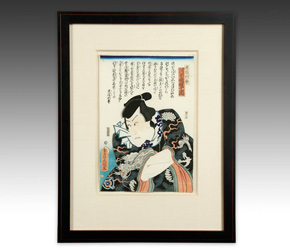 |
|
Edo, Tokyo, 1834
A late winter snow obscured the sunrise over Edo, casting the city in hushed grey tones. Vendors and stores were slow to open. Young girls with morning chores hurried on their way under oiled paper umbrellas while merchants wearing straw capes and bamboo hats jogged with heavier strides. Yet, despite the cold and early hour, a group of people were already lined up against the side of a famous publishing house buzzing with excitement. Among them were two brothers, Taichi and Yataro, both successful merchants with a love for ukiyo-e woodblock prints. Though considered by most aficionados to be commercial posters, the two brothers saw them as affordable works of art, especially the series that was to be released that morning.
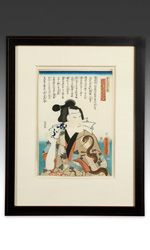 |
|
"As much as I'm looking forward to Hiroshige's next Tokaido print," Taichi was saying, breathing warm air into his cupped, freezing fingers, "I can't wait for Kunisada's kabuki print for the spring show!"
"You're starting to sound like Father, obsessing with those old-fashioned theater prints," Yataro laughed.
Taichi made a face. "Kunisada isn't old-fashioned, he's traditional – there’s a difference. Although, I do like the way he's using more vibrant colors now. Just wait and see, all the artists will be copying his style soon!"
"Kuniyoshi is the one to keep an eye on if you're looking for a master of color works," Yataro said, stamping his feet to keep warm. "I heard his latest print uses twelve different colors. Twelve!"
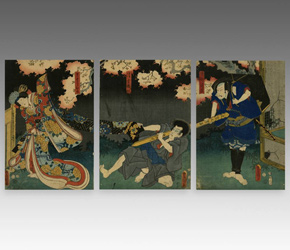 |
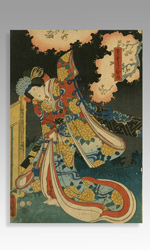 |
|
The two were soon caught up in a lively discussion of famous woodblock artists and especially the three masters of the Utagawa school who were taking the city by storm. They were Hiroshige, Kunisada and Kuniyoshi, each with distinct and diverse styles who represented, along with Yoshitsuya, the last ukiyo-e talents of the Edo period (1603-1868).
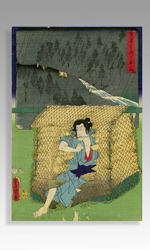 |
|
Utagawa Hiroshige (1797-1858)
Alternatively known as: Ando Hiroshige
The practice of woodblock printing during the mid-Edo period had solidified its tradition as commercial art illustrating for the most part, kabuki actors, sumo wrestlers, beautiful women and scenes of historical warriors and legends. The depiction of landscapes only came into fruition in the early 19th century, pioneered by Hokusai and solidified by Hiroshige. As a youth, Hiroshige sought apprenticeship under the head of the Utagawa school, Toyokuni, but the master had too many students already. Hiroshige was instead introduced to Utagawa Toyohiro, who had studied under Toyokuni, the first head of the Utagawa school. Unlike Toyokuni, Toyohiro's style was subtler, more refined and his subjects at times leaned towards views and landscapes – all characteristics that Hiroshige would incorporate into his own works. In a sense, it was a good thing Toyokuni had no room for Hiroshige!
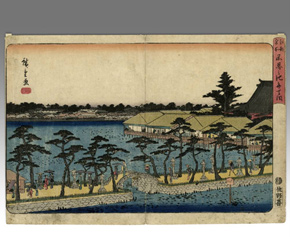 |
|
By 1800, the Utagawa school was particularly famous for producing excellent theater and entertainment prints, but Hiroshige departed completely from this tradition. Perhaps influenced by Hokusai's success with his nature prints, especially his famed "Thirty-Six Views of Mount Fuji," Hiroshige began working on landscape illustrations. In his own time, he studied the Chinese-based Kano style of painting as well as the realism-based Shijo style, both of which enhanced the beauty and creativity of his works.
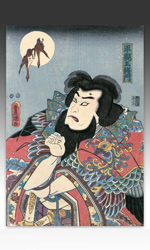 |
|
In 1832, Hiroshige found himself a part of an official procession from Edo to Kyoto along the Tokaido highway. Connecting the military and political capitals, the Tokaido ran along the east coast of Japan with 53 stations for travelers to rest. On average it took about half a month to make the journey on foot. During the trip Hiroshige made sketches of all the stations and the series, called "The Fifty-Three Stations of the Tokaido" was published between 1833 and 1834. There were in fact 55 prints in the series, including a view of Edobashi where the Tokaido began and the Great Sanjo Bridge in Kyoto where it ended. The series was an immediate success and Hiroshige created almost 30 different versions of various sizes and designs. It became his most famous work, noted for its striking use of unusual vantage points and weather to enhance the mood of each scene, as well as a sense of poetic beauty that permeated each of the views. Hiroshige's works would go on to deeply influence Western impressionist artists including Claude Monet and Vincent van Gogh.
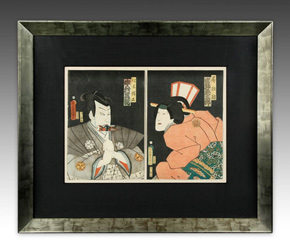 |
|
Utagawa Kunisada (1786-1865)
Alternatively known as: Toyokuni III
During his time, Kunisada was by far the most successful and well known ukiyo-e artist, surpassing all his contemporaries including Hokusai, Hiroshige and Kuniyoshi. As a child, his drawing abilities impressed Utagawa Toyokuni and he was apprenticed to the master in 1800. He soon became Toyokuni's most talented student, dubbed the star of the Utagawa school, and in 1813 ranked the second most important woodblock artist after his master.
Keeping with the Utagawa school traditions, the majority of Kunisada's prints were portraits of kabuki actors or dramatic scenes out of plays. Nevertheless his skills extended far beyond the theater to depict other genres including bijin-ga beauties, sumo wrestlers, shun-ga erotica and historical illustrations. He also collaborated with Hiroshige and Kuniyoshi, creating landscape and warriors prints. His productivity, too, exceeded his contemporaries. Scholars estimate he designed over 20,000 prints in his lifetime. His success and wealth allowed for Kunisada to employ many students and run a large workshop, no doubt providing him assistance in productivity.
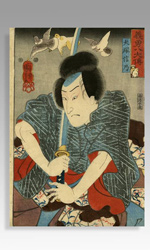 |
|
Utagawa Kuniyoshi (1797-1861)
Kuniyoshi's artistic pursuits began in childhood as the son of a silk-dyer. He assisted in pattern designs, undoubtedly forming a foundation for his mastery of color and textile arrangements in his prints. He was apprenticed to Utagawa Toyokuni in 1811 and became one of his important pupils. However, in the years following his independence, he failed to produce any noteworthy works and his economic situation turned desperate. It was while he was barely stringing together a living by repairing and selling second-hand straw mats that he happened to meet Kunisada. Seeing his fellow student surrounded by such success, Kuniyoshi redoubled his efforts, determined to prove that his artistic skills were superior to Kunisada's.
Kuniyoshi's breakthrough finally came in 1827 when he received a commission to produce prints for a series called "108 Heroes of the Suikoden," based on a 14th century Chinese novel popular at the time in Edo. The series was an instant success and Kuniyoshi continued to create prints depicting legendary heroes and warriors. His unique style, which included dreamlike elements, ghostly apparitions and impressive tattoos, was enthusiastically embraced by the public. So popular were his prints that he was frequently referred called "Warrior Kuniyoshi."
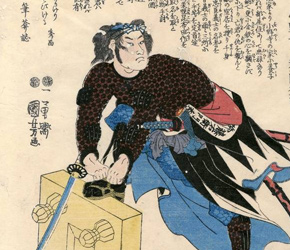 |
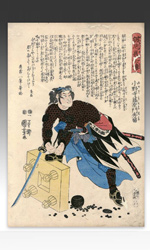 |
|
One of his most well-known series was the "47 Ronin," based on true events of the 18th century. The story follows a band of samurai who avenge their master's unjust death and restore his honor. The incident became well known and widely popular for demonstrating a samurai's code of honor and loyalty. The story was often retold in kabuki plays and illustrated by many woodblock print artists. Kuniyoshi was perhaps the most famous, having produced at least eleven complete series and over twenty triptychs on the subject.
Although most well known for his warrior prints, Kuniyoshi also showed great skills in other areas including beautiful women, ghosts, actors, landscapes and animals. An avid cat-lover, many of his prints feature the feline animals, at times predominantly and at other times tucked away in the background. It is said his students were often forced to vie for space in his workshop with a dozen cats. In his later years, Kuniyoshi also incorporated Western styles and perspective into his prints, especially in the way he depicted landscapes and illustrated the effects of light and shadow. Throughout his career, Kuniyoshi ingeniously used color, never failing to make a powerful, lasting impression on those who viewed his prints.
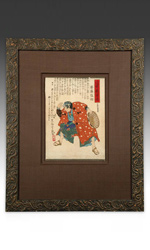 |
|
Utagawa Yoshitsuya (1822-1866)
Alternatively known as: Koko Yoshitsuya, Ichieisai Yoshitsuya
The late Edo period leading up to the Meiji Restoration in 1868 was a time of discontent, unrest and failed reforms. In particular, the Tempo Reforms of the 1840s impacted the ukiyo-e industry the most. In response to harsh famines and convoluted economics in urban areas, it was an effort to restore society back to its early Edo nature based on frugality, proper hierarchy and discipline. As a result, ukiyo-e artists were forbidden to portray beautiful courtesans or any form of luxury. In addition, restrictions were placed on the production of kabuki and historical prints to avoid the potential of political criticism.
It was during this time that Yoshitsuya, one of Kuniyoshi's students, was active. He witnessed his master getting in trouble time and again with authorities. While Kuniyoshi defied the oppression by disguising his messages in a comic-like style that nevertheless poked fun at the government, Yoshitsuya took up his master's old passion of warriors. In 1860, an event now known as the Sakuradamon Incident took place in which over a dozen masterless samurai from the Mito clan attacked and assassinated the Chief Minister Ii Naosuke. The minister had been actively involved in opening up the ports to foreign trade as well as using the military government's authority to suppress regional clans, including the Mito. At a time when public consensus was decidedly anti-government, the Mito assassins were seen as heroes and Yoshitsuya dedicated a series to them, titled, "Kinsei Giyuu Den" (Loyal Heroes of Recent Times). In a style similar to Kuniyoshi's "47 Ronin," each print depicts a warrior accompanied by a brief biography.
Yoshitsuya was the last prominent ukiyo-e artist of the Edo period. Though later critics and collectors saw Yoshitsuya's prints as 'cluttered,' the details in his epic battle scenes, often against mythical monsters, delighted the people of his time. The Meiji Restoration that took place two years after his death changed the entire country and the industry of ukiyo-e prints as new technologies and aesthetics were introduced to the long-isolated land. Although it was the beginning of the end of traditional woodblock printing, the next generation of artists – students of these Utagawa masters – produced some of the best known works in the genre.
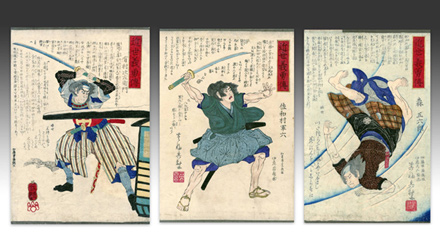 |
Download this Article: Masters of Color – Late Edo Period Ukiyo-e Artists.pdf